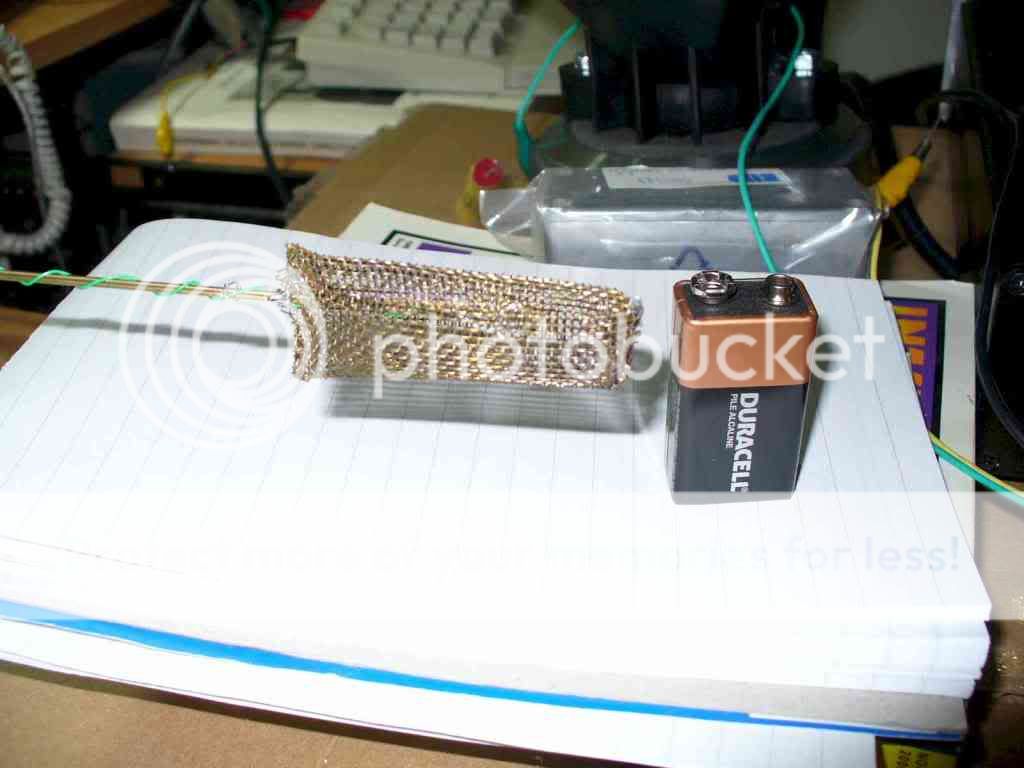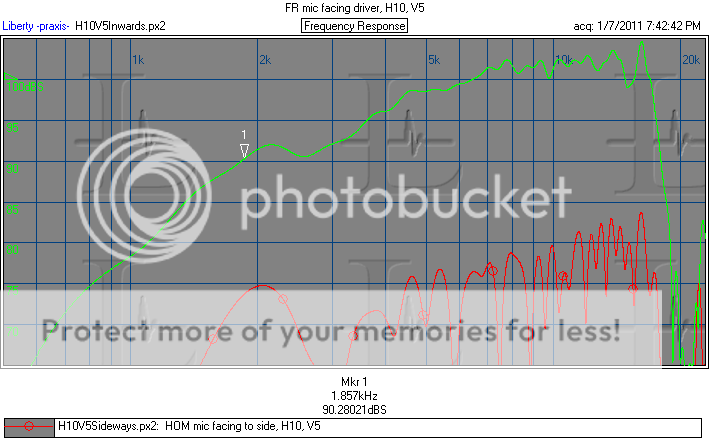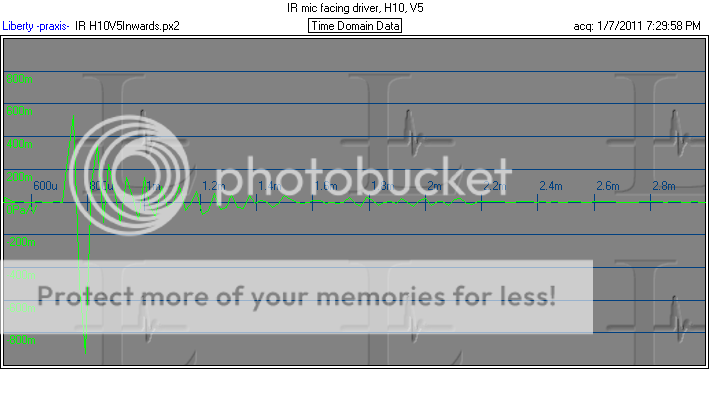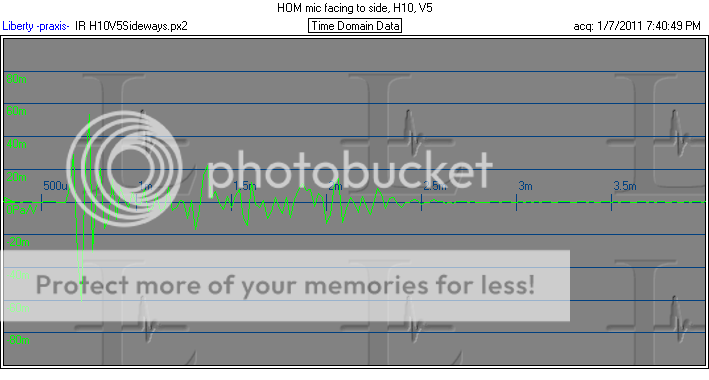bwaslo, I bet this periodicity is the undamped mike diaphragm after removing the back chamber.
This may be a bit premature, as I'm not sure I'm seeing what I'm trying for. I made a "particle velocity microphone" by removing the back from a miniature electret microphone (the usual WM62), exposing it to pressure from both sides. This gives it a directional characteristic, rejecting sounds coming in parallel with the diaphram (as a dipole is supposed to do).
I mounted this in some brass screen (for electrostatic shield) and made a (not very stable or versatile) holder for it one of those "third hand" circuit board holders. Here is a poor photo of the mic, next to a 9V battery for size (you can barely see the 6mm capsule inside the screen).

The capsule was positioned in front of a constant directivity horn (from a QSC HPR152i), first so that it faced inward toward the driver, and then rotated to achieve the deepest response null I could get. The measurements were made with a ~4msec window to avoid in-room reflections.
The idea of this is that the wanted wavefront from the guide should be spherical, which to a small enough capsule should be reasonably close to being planar. A velocity capsule (like this one is now, more or less) should reject planar waves coming at it edgewise, leaving wavefronts from HOM which will come at odd angles. Needless to say, no numerical measurements are likely from this scheme, but perhaps some comparative picture may be doable (such as evaluating foam or the effects of defects in the throat).
The frequency response from this capsule should be (and is) rising 6dB/octave up to around 20kHz, so keep that in mind in the response plots. The driver is a B&CD DE250. Notice how the mic's response flattens the mass controlled falling response of the driver!
Here are the measured responses, red is with the mic rotated for a null:

Here are the impulse responses corresponding to the responses, the direct-on response:

and the sideways-facing response:

There is a lot of periodicity in the nulls of the sideways response, which might indicate interference between the direct wave and perhaps a wave reflecting back down from the mouth (?) or maybe some other reflections in the setup such as off the mic arrangement (it is all small, but will still reflect some) or something else nearby. So what is left may or not be HOMs.
To be useful, this setup would have to be made more robust, better adjustable in three planes, and testing done in a better controlled environment. But I think it might show some possibilities.
Very interesting work! Many thanks for sharing!
There is a lot of periodicity in the nulls of the sideways response, which might indicate interference between the direct wave and perhaps a wave reflecting back down from the mouth (?) or maybe some other reflections in the setup such as off the mic arrangement (it is all small, but will still reflect some) or something else nearby. So what is left may or not be HOMs.
I would guess the periodicity is the reflection visible in the sideways curve at around 1.3m. Is that m for milliseconds or is it calculated meters? It is just as likely a reflection off of the floor, the cabinet, or something in the vicinity.
Figure out the delay between the direct response and the reflection, convert it to a distance and go looking for a reflection that corresponds.
David S.
I tried to get this working on a windows 7 machine using polar_map.application and setup.exe. Are there some more files that I need to get, I noticed polar_map.manifest in the error log.
Th app cannot be installed on a remote machine, it can only be run as a web app.
Controlling directivity below the waveguide also
Hello Earl (or other waveguide users),
Did you ever consider to make the bass-mid section "cardiod" like these guys did: Krypton³ | Amphion .
As most of the users of your speakers use a multiple sub approach, the bass-mids don't have to go very low, and the added cost would be minimal (2 additional cut-outs in the side panels and 2 thick pieces of open cell foam to fill-up these holes)
I know that you consider directivity below 1kHz less important, but I also remember you saying here that the linkwitz orion's 200-500 Hz region sounded excellent and maybe a little bit better than in your speakers. I see no other reason for sounding as good or better then the controlled directivity in that region. Dipole however I find less attractive, because you always have the back wave with makes speaker placement much more difficult. Cardiod seems to be the ideal solution, or am I totally missing something?
I would like to try it on my speakers, but before taking the router out, some advice would be very much appreciated.
Hello Earl (or other waveguide users),
Did you ever consider to make the bass-mid section "cardiod" like these guys did: Krypton³ | Amphion .
As most of the users of your speakers use a multiple sub approach, the bass-mids don't have to go very low, and the added cost would be minimal (2 additional cut-outs in the side panels and 2 thick pieces of open cell foam to fill-up these holes)
I know that you consider directivity below 1kHz less important, but I also remember you saying here that the linkwitz orion's 200-500 Hz region sounded excellent and maybe a little bit better than in your speakers. I see no other reason for sounding as good or better then the controlled directivity in that region. Dipole however I find less attractive, because you always have the back wave with makes speaker placement much more difficult. Cardiod seems to be the ideal solution, or am I totally missing something?
I would like to try it on my speakers, but before taking the router out, some advice would be very much appreciated.
Last edited:
This is how I get constant directivity at lower frequencies:
Works very well from the Schroeder frequency up.
Works very well from the Schroeder frequency up.
Hello Wayne,
Thanks for the quick reply. I thought about this kind approach, but I though it would only work good in a small frequency region:
- up to 200 Hz (modal region), the average listening room is to small to have benefit from this directivity
- from 200 to 400 Hz this probably works quite good
- above 400 Hz: you begin to have the negative effects of this corner loading (the 12" driver is not yet beaming, and the horn shape (corner) is less then ideal at these wavelengths, so some coloration will occur
I would think the cardiod can be made to work higher in frequency, and without any negative effects (except less low frequency output, which is not a problem if you use additional subwoofers).
Thanks for the quick reply. I thought about this kind approach, but I though it would only work good in a small frequency region:
- up to 200 Hz (modal region), the average listening room is to small to have benefit from this directivity
- from 200 to 400 Hz this probably works quite good
- above 400 Hz: you begin to have the negative effects of this corner loading (the 12" driver is not yet beaming, and the horn shape (corner) is less then ideal at these wavelengths, so some coloration will occur
I would think the cardiod can be made to work higher in frequency, and without any negative effects (except less low frequency output, which is not a problem if you use additional subwoofers).
It is true that below the Schroeder frequency, you'll need multiple sources to smoothe room modes. It is also true that the range from approximately 200Hz to 400Hz is where the cornerhorn provides the most benefit. Above that, and the sound source must be less than a foot away to be within 1/4λ. A quarter wave is actually about 9" at 400Hz, so the midrange sound source has to be in this vicinity to prevent self-interference. That's why I like to use a fairly large midhorn that provides 90° horizontal beamwidth, one that works from about 200Hz up. Have you ever considered doing that?
It's pretty easy to snug the midhorn back into the corner, close enough that it's mouth is within 1/4λ at the low end. That makes the walls act as an extension down low. Higher up, the horn sets the pattern. With the beamwidth maintained within the wall angle, you don't have a lot of reflected energy from them. And what reflections are there, are at very shallow angles because of the proximity to the source. I encourage you to give it a try and see what I mean.
It's pretty easy to snug the midhorn back into the corner, close enough that it's mouth is within 1/4λ at the low end. That makes the walls act as an extension down low. Higher up, the horn sets the pattern. With the beamwidth maintained within the wall angle, you don't have a lot of reflected energy from them. And what reflections are there, are at very shallow angles because of the proximity to the source. I encourage you to give it a try and see what I mean.
I wanted to be a little more clear, Wim, since I know you were talking about using a 12" direct radiating driver.
You can't expect the same behavior from a loudspeaker with a direct radiating 12" midwoofer and a waveguide or horn. If you put a speaker like that in the corner, it will suffer a self-interference notch from the adjacent walls. This is a lot like the floor bounce notch that occurs when putting a speaker on a stand.
But when you put a 90° midhorn in the corner, you do not see this self-interference notch. That same 12" driver, loaded into a constant-directivity midhorn, completely removes the notch. Its proximity to the corner prevents self-interference because it's closer than 1/4λ at the low end of its passband, so the walls actually serve as mouth extensions. At higher frequencies, the horn sets the pattern, maintaining constant beamwidth that is constrained to be inside the adjacent walls.
Another nice thing is the large 12" driver can probably handle a relatively low frequency so it can be blended with the woofer. This will reduce the floor bounce notch, which a two-way speaker on a stand would suffer from. It's the same approach as the multisub configuration, but at the upper end of the modal range. I noticed this when measuring cornerhorns (and vertical arrays, for that matter). They just don't have floor bounce notch because there are multiple sound sources in the lower midrange at the higher end of the modal range.
You can't expect the same behavior from a loudspeaker with a direct radiating 12" midwoofer and a waveguide or horn. If you put a speaker like that in the corner, it will suffer a self-interference notch from the adjacent walls. This is a lot like the floor bounce notch that occurs when putting a speaker on a stand.
But when you put a 90° midhorn in the corner, you do not see this self-interference notch. That same 12" driver, loaded into a constant-directivity midhorn, completely removes the notch. Its proximity to the corner prevents self-interference because it's closer than 1/4λ at the low end of its passband, so the walls actually serve as mouth extensions. At higher frequencies, the horn sets the pattern, maintaining constant beamwidth that is constrained to be inside the adjacent walls.
Another nice thing is the large 12" driver can probably handle a relatively low frequency so it can be blended with the woofer. This will reduce the floor bounce notch, which a two-way speaker on a stand would suffer from. It's the same approach as the multisub configuration, but at the upper end of the modal range. I noticed this when measuring cornerhorns (and vertical arrays, for that matter). They just don't have floor bounce notch because there are multiple sound sources in the lower midrange at the higher end of the modal range.
Hello Earl (or other waveguide users),
Did you ever consider to make the bass-mid section "cardiod"
As most of the users of your speakers use a multiple sub approach, the bass-mids don't have to go very low, and the added cost would be minimal (2 additional cut-outs in the side panels and 2 thick pieces of open cell foam to fill-up these holes)
I know that you consider directivity below 1kHz less important, but I also remember you saying here that the linkwitz orion's 200-500 Hz region sounded excellent and maybe a little bit better than in your speakers. I see no other reason for sounding as good or better then the controlled directivity in that region. Cardiod seems to be the ideal solution, or am I totally missing something?
I have considered cardiod, but not per your link because I don't believe that would work very well and they don;t show any supporting data. The problem is to do it right adds a lot of cost and woiuld push the price up considerably. My speakers maintain a good DI down to about 500 Hz. Increasing the DI from 250-500 Hz seems like a marginal task to me since we are simply not that sensitive to timing issue (reflections, etc.) at those frequencies.
And I think that I said that those frequencies where the Orions "best", but I am not sure that I thought that any portion of that design was "better" than mine. Comparable at the lower mid at best, but certainly not better.
I wanted to be a little more clear, Wim, since I know you were talking about using a 12" direct radiating driver.
You can't expect the same behavior from a loudspeaker with a direct radiating 12" midwoofer and a waveguide or horn. If you put a speaker like that in the corner, it will suffer a self-interference notch from the adjacent walls. This is a lot like the floor bounce notch that occurs when putting a speaker on a stand.
But when you put a 90° midhorn in the corner, you do not see this self-interference notch. That same 12" driver, loaded into a constant-directivity midhorn, completely removes the notch. Its proximity to the corner prevents self-interference because it's closer than 1/4λ at the low end of its passband, so the walls actually serve as mouth extensions. At higher frequencies, the horn sets the pattern, maintaining constant beamwidth that is constrained to be inside the adjacent walls.
Another nice thing is the large 12" driver can probably handle a relatively low frequency so it can be blended with the woofer. This will reduce the floor bounce notch, which a two-way speaker on a stand would suffer from. It's the same approach as the multisub configuration, but at the upper end of the modal range. I noticed this when measuring cornerhorns (and vertical arrays, for that matter). They just don't have floor bounce notch because there are multiple sound sources in the lower midrange at the higher end of the modal range.
That would indeed be a very good solution, but a bass-midhorn for a 12" driver is alot bigger (wider) then a 14" wide speaker. But if I had suitable corners, I would give it a try, because I think big speakers placed in a corner will look smaller then smaller speakers placed 0.5m away from the back wall.
Do you have any polar data available from this kind of setup?
I have considered cardiod, but not per your link because I don't believe that would work very well and they don;t show any supporting data.
I agree the speaker in the link was maybe not the best example how cardiod could be achieved, but it was the only example I could find of a cardiod bass-mid combined with a waveguide.
The problem is to do it right adds a lot of cost and woiuld push the price up considerably.
I can imagine there is an initial devellopment cost, but after that the addinoal parts/work are not that high:
- 2 blocks of open cell foam (agreed, this is not cheap) to put in the openings
- 2 additional cutouts in the side panels (or back panel)
My speakers maintain a good DI down to about 500 Hz. Increasing the DI from 250-500 Hz seems like a marginal task to me since we are simply not that sensitive to timing issue (reflections, etc.) at those frequencies.
Good DI down to 500 Hz is probably for the summa, but abbey and smaller models could benefit more. As said above, I would think the biggest cost is in the devellopment, but I was hoping devellopment would be pretty straigtforward for you as you have a few chapters in your book about cardiods and low frequency directivity that includes a mathematical model and some simulated polars. Also the cardioid does not need to be perfect (probably impossible without DSP and 2 active sources), but I figured some additional directivity would not be a very complex task.
I And I think that I said that those frequencies where the Orions "best", but I am not sure that I thought that any portion of that design was "better" than mine. Comparable at the lower mid at best, but certainly not better.
I aksed the question because of your post http://www.diyaudio.com/forums/multi-way/100392-beyond-ariel-674.html#post2249210 and http://www.diyaudio.com/forums/multi-way/100392-beyond-ariel-674.html#post2249304
Do you have any polar data available from this kind of setup?
Measurements are posted on my site. I do a series of equally-spaced off-axis measurements for each of my constant directivity speakers. One thing about the constant directivity cornerhorns, polars are very boring. Pretty much nothing changes as you move the microphone along the horizontal.
If you think about it, the horizontal polars of most horn/waveguide speakers are pretty uniform at higher frequency. It's down low where the coverage balloons. But when you confine the pattern to eighth-space, the balloon can't happen. So the polars become uniform all the way down to the Schroeder frequency.
Measurements are posted on my site. I do a series of equally-spaced off-axis measurements for each of my constant directivity speakers. QUOTE]
Hello Wayne,
I only see the following directional measurements at your site:
Seven π loudspeaker, with measurement microphone 4 feet up, 8 feet back, directly on-axis (on-axis)
Seven π loudspeaker, with measurement microphone 4 feet up, 8 feet back, 3.5 feet over (20° off-axis)
Seven π loudspeaker, with measurement microphone 4 feet up, 8 feet back, 7 feet over (40° off-axis)
These do not tell very much. I was hoping for a resolution of minimum 10° with all measurements in one graph so it is easy to see what is going on. Sonograms would even be better. Arta makes very nice plots.
Polars definitely are not boring, but are the most interesting measurements I know of, independent of the speaker type
But when you confine the pattern to eighth-space, the balloon can't happen. So the polars become uniform all the way down to the Schroeder frequency.
A practical solution.
With placing just any old speaker in the corner, the constraining would involve reflection. This would mean higher order modes. This may not be so much the case if you correctly throat the bass/mid driver, do you feel that this is necessary?
Furthermore, would it be such a bad idea to place a 90 degree coverage tweeter waveguide directly in a corner, at 45 degrees, and shroud the surrounding walls with absorptive material?
I only see the following directional measurements at your site:
Seven π loudspeaker, with measurement microphone 4 feet up, 8 feet back, directly on-axis (on-axis)
Seven π loudspeaker, with measurement microphone 4 feet up, 8 feet back, 3.5 feet over (20° off-axis)
Seven π loudspeaker, with measurement microphone 4 feet up, 8 feet back, 7 feet over (40° off-axis)
These do not tell very much. I was hoping for a resolution of minimum 10° with all measurements in one graph so it is easy to see what is going on. Sonograms would even be better. Arta makes very nice plots.
Well, that's very true. And those particular measurements were with the PSD2002 compression driver, which has a fair amount of breakup. I really do need to get more measurements of that speaker, like I have for the four π loudspeaker, as an example.
I can tell you this though, you can move the measurement microphone all around in the horizontal plane and just not see any real change. That's the beauty of this configuration.
With placing just any old speaker in the corner, the constraining would involve reflection. This would mean higher order modes. This may not be so much the case if you correctly throat the bass/mid driver, do you feel that this is necessary?
Yes, that's right. This won't work with "just any old speaker in the corner".
Rather, what is necessary is that the sound sources either be within 1/4λ of the walls or that they be directional enough to control the pattern, confining the beamwidth within the walls. So at low frequencies, you have one condition and at higher frequencies, a different condition.
If a sound source is within 1/4λ of the apex of the corner, then the corner sets the pattern, forcing radiation into 1/8th space, a constant 90° pattern.
This is only true from the Schroeder frequency upwards, of course. But multiple subs can be used below that point to provide uniform coverage at the lowest frequencies.
At higher frequencies, the corner should not be relied upon to set the pattern. If the boundaries are acoustically distant, then they will create reflections. As an example, a direct radiating midrange (or midwoofer) set near a corner will suffer from self-interference, and response notches will result.
That's why the midrange and tweeter of a constant directivity cornerhorn must be horn/waveguides with 90° beamwidth. It matches the lower frequency pattern and reduces side wall reflections.
So if a speaker were conventionally mounted on a corner baffle back with it's edges adjacent to the walls, naturally this wouldn't be as good a coupling to the corner, but if one wanted the speaker to face forward to get the upper mids from it could this be made to work well enough?
If you're describing a driver mounted in the wall, radiating from the corner, then, yes, I see no reason that wouldn't work well. Naturally, the driver/throat interface and any sort of phase plug you might want to use is still up to you.
- Home
- Loudspeakers
- Multi-Way
- Geddes on Waveguides